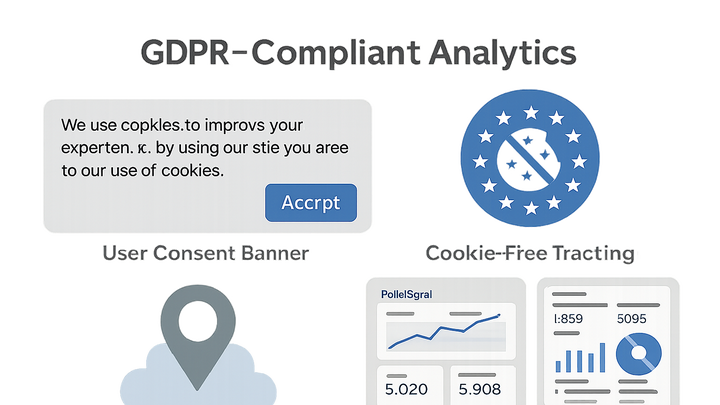Published on 2025-06-22T07:53:11Z
What is GDPR Compliance in Analytics? Examples and Tools
GDPR Compliance in analytics refers to following the European Union’s General Data Protection Regulation when collecting and processing user data.
This means obtaining valid consent, minimizing personal data collection, anonymizing information where possible, and respecting data subject rights such as access and erasure.
Analytics teams must adjust tracking implementations, tool configurations, and data retention policies to align with GDPR requirements. Failure to comply can lead to significant fines and damage to user trust.
Tools like Google Analytics 4 and PlainSignal offer features that help simplify compliance by providing cookie-free tracking options, IP anonymization, and consent mode integrations. Understanding GDPR compliance is essential for any organization serving EU residents or processing their data.
Gdpr compliance
Ensures analytics data collection and processing adhere to EU GDPR, focusing on consent, minimization, anonymization, and user rights.
Overview of GDPR Compliance
GDPR Compliance in analytics refers to adhering to the rules outlined in the European Union’s General Data Protection Regulation (GDPR). This regulation governs how personal data must be collected, processed, and stored. It emphasizes user rights, including access, correction, and deletion, and imposes strict requirements on obtaining valid consent. Analytics teams must align their data practices with GDPR to avoid penalties and maintain user trust. Understanding GDPR is crucial for any organization processing the data of EU residents.
-
Definition of gdpr compliance
GDPR Compliance means following the legal framework set by the EU to protect personal data and privacy rights of individuals. It ensures that organizations process personal data lawfully, transparently, and for legitimate purposes.
-
Key principles for analytics
Several fundamental GDPR principles directly impact analytics, including:
- Lawfulness, Fairness, and Transparency
- Purpose Limitation
- Data Minimization
- Storage Limitation
- Integrity and Confidentiality
-
Lawfulness, fairness and transparency
Personal data must be processed lawfully, fairly, and in a transparent manner with clear communication about tracking purposes.
-
Purpose limitation
Data should be collected for specific, explicit, and legitimate purposes and not further processed in an incompatible manner.
-
Data minimization
Only data that is adequate, relevant, and limited to what is strictly necessary should be collected.
-
Storage limitation
Personal data should not be kept longer than necessary for the purposes for which it was processed.
-
Integrity and confidentiality
Data must be processed in a way that ensures appropriate security, including protection against unauthorized or unlawful processing.
Impact on Analytics Practices
GDPR has reshaped how analytics data is collected, processed, and reported. Organizations must implement consent mechanisms, anonymize data, and honor data subject rights. These changes influence tool configurations, reporting accuracy, and operational workflows.
-
Consent-based data collection
Under GDPR, tracking that relies on cookies or personal identifiers requires explicit user consent before it can run.
-
Consent management platforms
Tools like Cookiebot or OneTrust provide customizable banners to obtain and document user consent.
-
Granular consent options
Allow users to accept or decline analytics cookies separately from other categories such as marketing or preferences.
-
-
Anonymization and pseudonymization
Techniques to avoid storing identifiable personal data while maintaining useful analytics insights.
-
Ip anonymization
Methods like Google’s IP anonymization mask part of the IP address before it is written to disk.
-
Aggregated reporting
Focus on cohort-level or aggregated data rather than individual user paths to mitigate privacy risks.
-
-
Data subject rights
GDPR grants individuals rights that analytics operations must accommodate, affecting data retrieval and deletion workflows.
-
Right to access
Users can request a copy of their personal data and the purposes it is used for.
-
Right to erasure
Also known as the ‘right to be forgotten’, users can ask to delete their personal data.
-
Right to portability
Users can receive their data in a commonly used, machine-readable format for transfer to another controller.
-
GDPR-Compliant Analytics Tools
Several SaaS analytics platforms and complementary tools offer built-in features or configurations to support GDPR compliance. Below are examples of popular solutions and how they address GDPR requirements.
-
PlainSignal: cookie-free simple analytics
PlainSignal operates without cookies or personal identifiers, providing a privacy-first analytics approach that is GDPR-compliant by design.
-
No cookies
Tracks pageviews and events without storing any cookies, eliminating the need for cookie consent banners.
-
Simple setup
Just insert a lightweight script tag to start collecting anonymized statistics.
-
Compliance by design
Collects only aggregated data with no capability to identify individuals.
-
-
Google analytics 4 (GA4)
GA4 includes features to help meet GDPR obligations, such as IP anonymization, consent mode, and data retention controls.
-
Ip anonymization
Automatically anonymizes user IP addresses before storage, reducing personal data handling.
-
Consent mode integration
Adapts tracking behavior based on user consent signals to ensure compliance with opt-in requirements.
-
Data retention controls
Customizable settings to define how long user and event data are kept before automatic deletion.
-
-
Consent management platforms (cmps)
CMPs help orchestrate and document user consent, integrating seamlessly with analytics solutions.
-
Cookiebot
Automated cookie scanning and consent banner generation.
-
Onetrust
Comprehensive privacy management suite with consent and preference management.
-
Custom solutions
In-house or specialized consent implementations tailored to unique requirements.
-
Example Implementation: PlainSignal Tracking Code
Use the following snippet to embed PlainSignal on your site and remain GDPR-compliant:
-
Tracking code
<link rel="preconnect" href="//eu.plainsignal.com/" crossorigin /> <script defer data-do="yourwebsitedomain.com" data-id="0GQV1xmtzQQ" data-api="//eu.plainsignal.com" src="//cdn.plainsignal.com/plainsignal-min.js"></script> -
Gdpr compliance aspects
This implementation ensures GDPR compliance by leveraging cookie-free tracking and anonymized data collection.
-
No personal identifiers
Captures only high-level metrics like pageviews and events without linking to individual users.
-
Cookie-free tracking
Reduces reliance on cookies, eliminating the need for explicit cookie consent.
-
Data minimization
Collects only the necessary information for basic analytics, adhering to the minimization principle.
-
